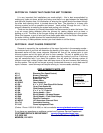
5. The combustor can be removed by dropping the flame impingement plate as
described and then the four (4) 3/8” brass nuts (they take a 9/16” wrench) that hold in
the combustor collar (Part #CA-1710). This will give you full access to the catalytic
combustor. At this point the manufacturer’s cleaning instructions should be followed.
6. This procedure can be reversed to reassemble the combustor in the stove.
B. Gaskets
Each unit has a gasket (Part #AC-DGKC) around the door, which should be replaced
every two years. Prior to replacing this gasket the old material must be removed
completely – this may require you to scrape the old gasket and adhesive from the
channel. After this surface is clean the new adhesive and gasket can be installed. The
door should be latched closed for approx. 24 hours to allow the adhesive to harden.
If you are replacing the window gasket (Part #AC-GGK), the gasket already has
adhesive on one side. Remove the window first by taking out the two screws that hold
the glass in the opening. Then remove the paper backing in the new kit and, while
forming a “U” with your fingers, run the new gasket completely around the outer
perimeter of the glass. The glass can be put back in the window opening and tightened
in place. Both gasket kits can be ordered from your local dealer or from the factory.
C. Firebrick (Part #AC-SB)
This stove is equipped with high density, high temperature firebrick. If the brick
becomes chipped or cracked, especially on the sides of the firebox, it should be
replaced. The brick can be ordered from your local dealer or from the factory.
D. Finish (Part #AC-MCSP; 12oz. Spray Can)
Your stove has been painted with 1200 degree Metallic Charcoal paint that will retain
its original appearance for years. However, if your stove should get wet, some rust spots
might appear. These can be removed with plain steel wool and touched up with new
paint. If you need to do any painting of the unit we highly recommend using our paint, as
others might not adhere to the surface. This paint can be ordered from your local dealer
or from the factory.
E. Blower System (Part #AC-17)
The blower system for this unit is placed under the ash lip and moves air under,
around and finally exits over the top front of the stove. This blower should be removed
and cleaned at least once a year; you can use a vacuum cleaner to remove any loose
dust build-up, but do not disassemble the blower. This part has sealed bearings and
does not require any oil.
F. Glass Cleaning
Even though this stove is equipped with an air wash system, it will be necessary to
clean the window regularly. The type wood and the mode in which you operate the unit
can contribute to a dirty viewing glass. The glass can be cleaned with a stove glass
cleaner or a solution of ammonia and water.
SECTION VII: CHIMNEY MAINTENANCE
Cleaning your chimney system is not a difficult task, and many homeowners choose
to do this job, but we highly recommend the use of a chimney sweep to clean and
inspect the entire system. Remember, a professional can spot problems the homeowner
may overlook.
NOTE: It is a good idea to thoroughly clean your stove and chimney in
the spring to eliminate any lingering odor through the summer months.













